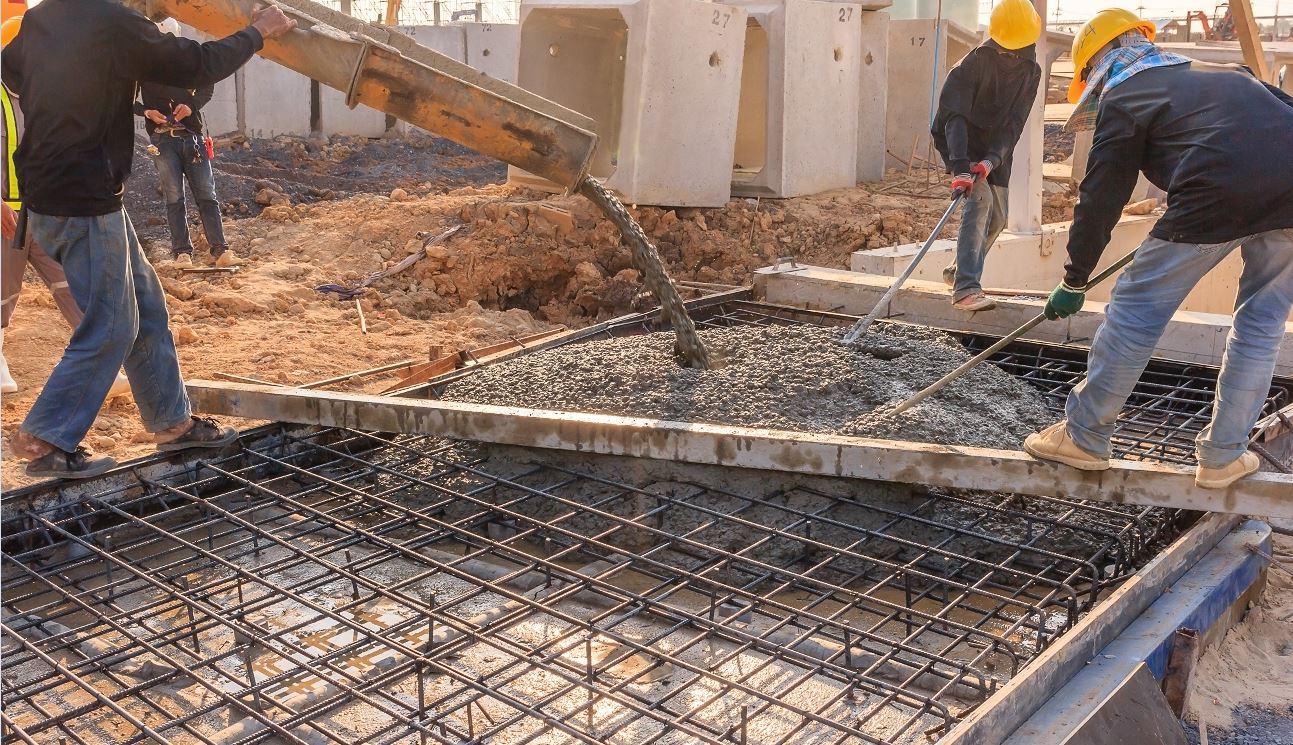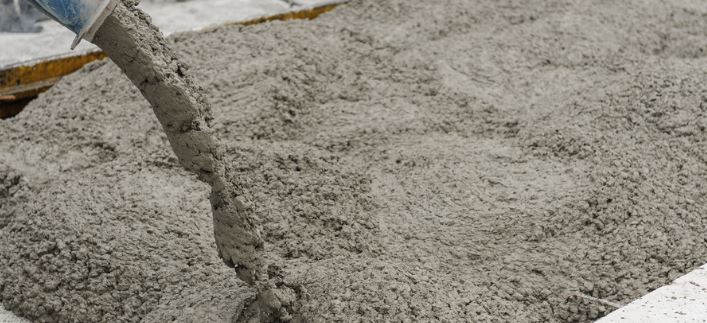Revolutionizing Construction: Self-Consolidating Concrete

Advantages of Self-Consolidating Concrete in Construction
From intricate architectural designs to large-scale infrastructure projects, self-consolidating concrete (SCC) promises superior aesthetics and durability in various applications.
SCC is a revolutionary construction material that effortlessly flows into the tightest spaces, largely eliminating the need for manual compaction. Read on to explore the limitless possibilities of self-consolidating concrete.
What is self-consolidating concrete
For starters, let’s answer some basic questions about self-consolidating concrete. It is an ingenious construction material with an exceptional ability to flow. It can fill intricate molds and tight spaces without mechanical consolidation such as vibration or compaction. Its unique blend of high fluidity and stability ensures uniform distribution, reducing the risk of air pockets and enhancing structural integrity.
Self-consolidating concrete improves work efficiency by simplifying complex casting, reducing labor costs (and time), and delivering superior surface finishes. It's ideal for more intricate architectural designs, densely reinforced structures, and congested formwork. SCC streamlines construction processes without sacrificing durability or aesthetics.
Key Properties of Self-Consolidating Concrete
Self-consolidating concrete possesses several key properties that distinguish it from conventional concrete and make it suitable for various applications. Here are some of the key properties of SCC mixtures:
-
Segregation Resistance: SCC is a flowable, non-segregating concrete. This means that the constituents of the mixture, such as aggregates and cement paste, do not separate during placement. This property ensures uniform distribution of materials and helps maintain consistent properties throughout the concrete.
-
Self-Compacting: As the name suggests, SCC can compact itself under its own weight. This ensures complete filling of formwork and proper consolidation, even in areas where access is limited or vibration is impractical.
-
Homogeneity: SCC produces a uniform and homogeneous mixture, resulting in consistent color, texture, and strength throughout the concrete element.
-
Minimal Bleeding: Bleeding refers to the separation of water from the concrete mixture, which can lead to surface defects and reduced durability. SCC is designed to minimize bleeding, helping to maintain a smooth surface finish.
-
Reduced Formwork Pressure: SCC exerts lower pressure on formwork compared to traditional concrete. This reduces the risk of formwork failure and allows for the use of more intricate and complex formwork designs.
-
Smooth Surface Finish: It can produce high-quality surface finishes without the need for additional finishing techniques. This is particularly important for architectural concrete elements.
-
High Strength and Durability: You can formulate SCC to achieve high compressive strength and durability. This durability makes it suitable for structural applications and projects with specific performance requirements.
-
Improved Workability: It provides improved workability for construction workers, making the placement process more efficient and less physically demanding.
-
Reduced Noise and Vibration: The absence of vibration equipment during placement reduces noise pollution and vibration-related concerns at construction sites.


Advantages of SCC Over Traditional Concrete
Self-consolidating concrete presents a range of advantages over traditional concrete and has reshaped the landscape of construction methodologies. These are the top six advantages of self-consolidating concrete:
-
Remarkable Flowability: SCC's remarkable flowability is one of its most distinctive features. Traditional concrete requires extensive manual or mechanical vibration to fill formwork and achieve proper compaction. SCC flows effortlessly and naturally into even the most intricate and confined spaces. It ensures that every nook and cranny is adequately filled, minimizing the risk of voids, honeycombing, and other imperfections.
-
Superior Stability through Reduced Segregation: SCC's resistance to segregation sets it apart from conventional concrete. Segregation occurs when heavier aggregates settle at the bottom of the mixture and water rises to the top, leading to an uneven distribution of components and compromised concrete quality. Its unique formulation and self-compacting nature effectively combat this issue. This maintains a consistent mix and prevents the separation of aggregates and cement paste.
-
Versatility: SCC's versatility is a major advantage in diverse construction scenarios. Its ability to flow smoothly and self-compacting nature makes it an ideal choice for a wide range of applications. Whether used in complex reinforced structures, precast components, or repair and retrofitting projects, it adapts to the specific requirements of each application.
-
Time-Saving: SCC's self-compacting properties significantly accelerate the concrete placement process, resulting in time savings during construction. The absence of manual compaction and vibration equipment reduces the time needed to complete concrete pours. Additionally, its ability to rapidly fill complex formwork and tight spaces ensures that construction progresses at a faster pace, shortening project timelines.
-
Cost-Saving: SCC's time-saving advantages translate directly into cost savings. The quicker placement and reduced labor requirements decrease on-site labor costs. Furthermore, the elimination of vibration equipment and the associated maintenance and operation costs contribute to overall project cost reduction.
Self-consolidating concrete provides a powerful solution that enhances construction efficiency, quality, and aesthetics across a wide array of projects. However, successful implementation requires careful mix design, quality control, and adherence to recommended practices to fully harness the benefits that SCC offers.
Best Uses for Self-Consolidating Concrete
Self-consolidating concrete is highly beneficial for the construction industry due to its unique properties and advantages that streamline the construction process, improve quality, and enhance overall project outcomes.
While self-consolidating concrete is incredibly versatile and widely utilized in many different projects, its optimal use is in intricate architectural designs. Its ability to replicate fine formwork details superior aesthetics, and it excels in densely reinforced structures as the mixture navigates congested spaces with great ease.
Enhanced homogeneity minimizes the prevalence of air pockets, strengthening structures and improving overall finish quality. SCC maximizes efficiency, ensures longevity, and looks great in various diverse construction projects.
Testing Self-Consolidating Concrete
Testing SCC construction is an important part of ensuring its performance and longevity. The unique properties of SCC – highly flowable, non-segregating, and self-leveling behavior – demand specific testing methods.
Workability tests like the slump flow test and T50 time help to assess SCC’s ability to flow and fill molds effectively. These tests provide invaluable insights into its consistency and potential for segregation. Viscosity measurements further help to evaluate SCC’s resistance to segregation during the transportation and placement stages.
Segregation resistance tests examine SCC’s ability to prevent aggregate separation, ensuring homogeneity and cohesion throughout the structure. Tests like the V-funnel and L-box assess stability and passing ability through constrictions.
Fresh properties (like air content and bleeding) are also evaluated to guarantee its quality before setting. Strength tests like compressive and flexural strength ascertain its durability and load-bearing capabilities.
To gauge SCC’s performance in real-world conditions, field tests can be deployed to assess its filling ability, its ability to pass through reinforcing bars, and achieve complete formwork coverage.
The rigorous testing of SCC ensures its optimum performance, allowing construction professionals to harness its unique properties while providing structural reliability and longevity in a wide range of applications.


Origins and Evolution of Self-Consolidating Concrete
The origins of self-consolidating concrete can be traced back to the 1980s – particularly in Japan – where the concept of “high-performance concrete” was being explored. SCC was subsequently developed to respond to the challenges posed by congested reinforcement and complex formwork in modern construction applications. The ultimate goal was to create a concrete mix that could flow easily into tight spaces without the need for vibration, reducing labor and improving outcomes.
Early formulations of SCC focused on attempting to achieve high flowability through modifications to the mix design, incorporating superplasticizers viscosity-modifying admixtures. These special additives improved the fluidity of the concrete while allowing the finished product to maintain its stability and avoid segregation.
Since its inception, SCC has come a long way. Research efforts worldwide have led to a deeper understanding of its properties as well as its potential applications.
The mixture designs have become more sophisticated with more balance between high flowability and stability. Additionally, the development of more specialized equipment (like self-compacting molds and mixers) has further facilitated SCC’s applicability in a wide range of projects.
In contemporary settings, SCC is recognized as a revolutionary material for numerous construction projects due to its ability to simplify complex casting, enhance structural integrity, and deliver impressive surface finishes.
Its evolution is ongoing as research continues to optimize its properties by exploring new additives and expanding the range of applications across varying construction scenarios.
Modern Examples of SCC
Iconic structures like the Burj Khalifa in Dubai have utilized self-consolidating concrete for their efficiency in casting intricate architectural features. The Marina Bay Sands in Singapore also utilized SCC in order to achieve the seamless curves on its distinctive roof. The Akashi Kaikyō Bridge in Japan needed SCC for its dense reinforcement and complex geometries.
These examples highlight the versatility and functionality of SCC and the material’s role in shaping modern architectural marvels.
Where to find Concrete Construction Supplies
Embrace the latest and greatest technologies and cementitious materials in construction and find out how self-consolidating concrete can improve your projects. Its unmatched flowability, self-leveling properties, and stability have redefined building practices as we know them.
From iconic skyscrapers to intricate, personalized designs, SCC is a key element in numerous modern construction projects. To explore its potential and embark on your journey of innovation, visit our products and explore our website to experience SCC’s transformative capabilities firsthand.
- Protecting Worksites from Dropped Object Hazards: Essential Tools for Elevated Safety
- 5 Ways to Use the Vers-A-Scoop (Beyond Just Masonry Work)
- Deslauriers: Leading the Way in Sustainable Manufacturing
- 5 mistakes to avoid when using concrete test scoop
- Troubleshooting Common Problems with Air Pressure
- Construction materials
- shims
- shims in construction
- concrete
- construction
- Steel columns
- Building support structures
- Structural design
- Types of steel columns
- H-beams
- I-beams
- Pipe columns
- Box columns
- Steel-concrete composite columns
- Construction projects.
- Concrete Column Form
- Concrete Column Form Rent
- Buy Concrete Column Forms
- Construction temperature control
- Thermostatic technology
- Concrete curing
- Temperature regulation
- Construction equipment
- Advanced curing techniques
- Concrete strength optimization
- Structural integrity
- Construction safety
- Composite wood shims
- construction shims
- durability of composite shims
- Lifting Handle Guide
- Lifting Handle best practices
- Dowel Caps
- Concrete Placement in Construction
- Construction Efficiency
- Concrete Placement in Construction Projects
- sustainable construction
- cost-effective building materials
- sustainable building benefits
- environmental impact
- on-site training
- deslauriers services
- construction training
- Equipment Maintenance
- Testing Equipment Care
- Rust Prevention
- Compression Testing Equipment
- Equipment longevity
- column formwork
- concrete formwork


